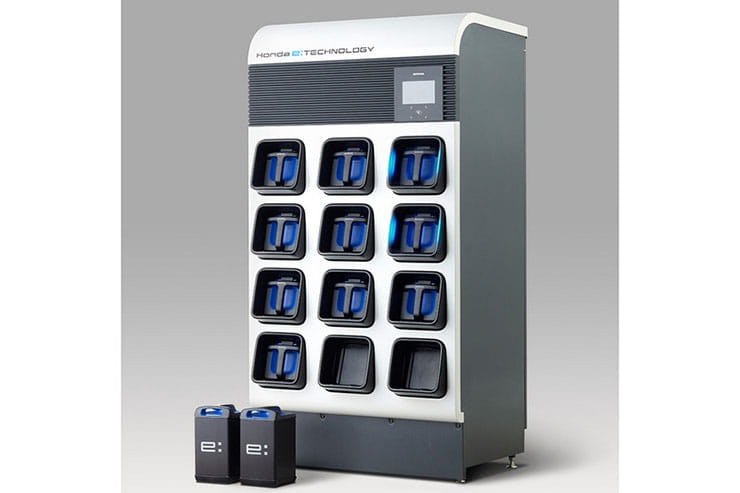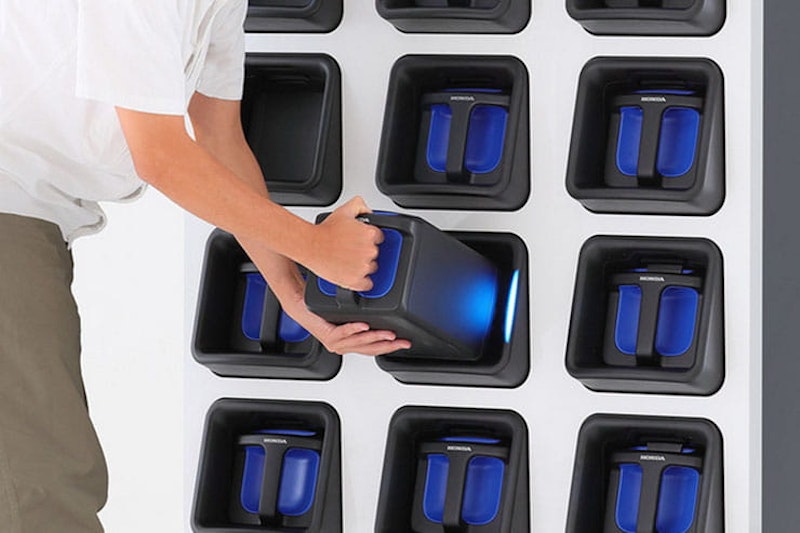Honda battery-swap station reaches production
By Ben Purvis
Motorcycle Journalist
25.10.2022
Honda has been touting the idea of a swappable battery infrastructure that allows motorcycles, scooters and other vehicles to share the same interchangeable power packs for several years – and now it’s taken a huge step by putting the Honda Power Pack Exchanger e: on the market.
Initially available in Japan and India, the Honda Power Pack Exchanger e: is the counterpart to the Honda Mobile Power Pack e:, which is the battery unit that the company hopes will become the standard across a host of different vehicles in years to come. The Honda Mobile Power Pack e: is the successor to the original Honda Mobile Power Pack, introduced in 2017 for bikes like the PCX Electric, and initially it’s being used as the battery for the Honda Gyro Canopy e: electric three-wheeler that’s already on the market in Japan, targeting delivery companies.
Battery-swappable scooters are already a big deal in some parts of the world, notably Taiwan where 10 different brands and 47 models of bike have adopted the Gogoro battery pack, allowing them to use more than 2300 ‘GoStations’ to swap dead batteries for fresh ones.
Honda’s Mobile Power Pack Exchanger e: follows much the same idea, and even looks a lot like the Gogoro GoStation with rows of batteries arranged in a wall of charging slots. The batteries are locked in place and charge automatically as soon as they’re slotted in. Users have a smart card that they can tap on a panel on the charger, which will then release a fully charged pack. You simply pull it out, put it in your bike and slot your old, discharged Mobile Power Pack e: in its place on the Mobile Power Pack Exchanger e:.
Wall of Honda Mobile Power Pack Exchanger e: units can be created by using one main ‘control’ unit and allying it to additional ‘extension’ units, which look the same but lack sensor to tap your ID card on.
Cleverly, the MPP Exchanger e: itself can be powered by a Mobile Power Pack e:, so if there mains electricity supply is cut off, during a power cut, for instance, it will still allow customers to retrieve charged batteries (it won’t work as a charger without mains power, of course).
Initially, Honda is offering the units in Japan and in India, where a subsidiary company is starting a battery sharing service using the Mobile Power Pack e: in electric rickshaw taxis.
In Japan, the first production Mobile Power Pack Exchanger e: units have been sold to Gachaco Inc, a joint venture between Honda, Yamaha, Kawasaki, Suzuki and ENEOS Holdings that’s a clear indication that rivals are likely to adopt the same Honda Mobile Power Pack e: as a standardised electric bike battery in the future.
Honda hopes the system ‘can achieve widespread use inside and outside of Japan’ and there’s a good chance that in the not-too-distant future chargers like these could be as ubiquitous as petrol pumps.
In Europe, Honda is leading another consortium – including the likes of Piaggio and KTM – to achieve a similar consensus on standard, swappable batteries. It’s clear that the Honda standard established in Japan and used in the Mobile Power Pack e: and the Mobile Power Pack Exchanger e: must be have a good chance of being adopted by that group, which will surely see the same units appearing over here.
Share on social media:

